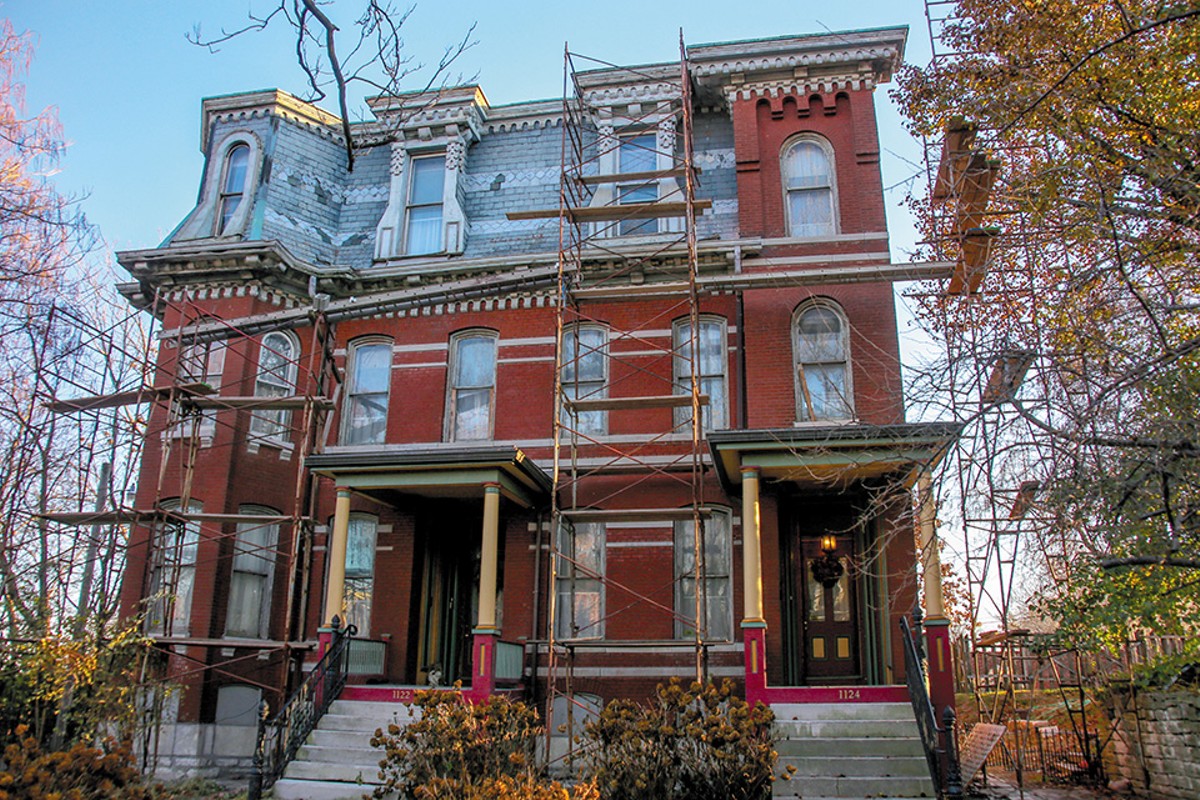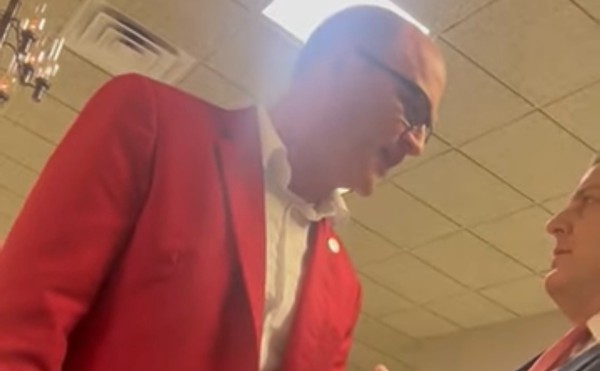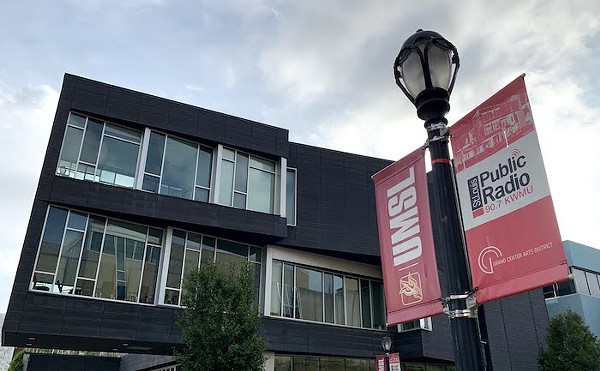In a normal American city — one that possesses many of the same attributes as St. Louis, but with another sense of spirit, different values — Hyde Park wouldn’t be discussed as a turnaround story. In an alternative universe, the place never would have spiraled into turmoil in the first place.
Even considering the panoply of ills that affected post-World War II St. Louis (white flight, GI loans that made county living attractive, racial unease, poor public transport … the list does go on), Hyde Park still had the buildings (gorgeous), the land (plentiful) and the roads (right along I-70) to avert crisis. But the flight from north city was severe even by Rust Belt standards, and with a rapidly declining population, many of the buildings tumbled or languished. And so the roads became cut-throughs out of, instead of into, a neighborhood that dates back to the 1840s, with early-twentieth-century density that would’ve been the envy of any corner of St. Louis.
Settled by German immigrants, Hyde Park was originally a township named Bremen. Though a street with that name appears on the map today, the township was annexed and renamed after the park in its center. Today the neighborhood, a misshapen triangle tucked alongside the highway between Old North and Fairgrounds Park, is 84 percent black. Its housing units are 45 percent vacant.
Yet despite long periods of decline, Hyde Park never fully cratered. Enough people either clung to their businesses or homes or elected to find their bliss here despite troubling trends that they created an environment that’s been close to full-scale re-blossoming for decades now. One keen north city observer says that at least three waves of redevelopment have almost happened in Hyde Park over the past 30 years. That some happened in part, but not whole, only adds to the intrigue.
Driving through the neighborhood or walking its blocks, you can see the spurts of activity, set against the losses of past decades. And in 2018, some key indicators suggest a tipping point is finally within reach. Neighboring Old North has become a destination for art lovers and urban homesteaders, even as the National Geospatial-Intelligence Agency is building a new home for its 3,000 employees in nearby Carr Square. And within Hyde Park itself, restaurants are opening, rather than closing. New homes are selling for low six-figure sums (even though you can still get the shell of a vacant for $2,500, condition emphatically as-is). Building permits issued in the neighborhood in 2018 to date are valued at $4.2 million.
Some whole blocks still have broken-teeth syndrome, with ugly gaps between the intact housing stock, while some buildings threaten to implode before the clock strikes 2019. And the 2014 demolition of the 119-year-old Bethlehem Lutheran Church felt like a great loss.
But Chris Naffziger, a blogger on history, architecture and preservation for St. Louis Magazine as well as his own site, St. Louis Patina, feels bullish on Hyde Park’s future.
For all the neighborhood’s troubles, he says, “there’s so much good news.” In addition to a food renaissance, with several exciting new restaurants opening their doors, “there is all sort of historic rehabbing and new construction happening for affordable housing, and there is a strong neighborhood association.
“The architecture is equal to Lafayette Square. Benton Park or Soulard. Yes, it is. I stake my reputation on it. I think in ten years, Hyde Park could be a model for creating an equitable and thriving north St. Louis community.”
And if that happens — if the skeptics are wrong and the optimists are right — it won’t be because of any grand redevelopment scheme, or because of the NGA or because of a big plan out of City Hall. It will be because people invested in a community that others had given up on.
Here are three of their stories.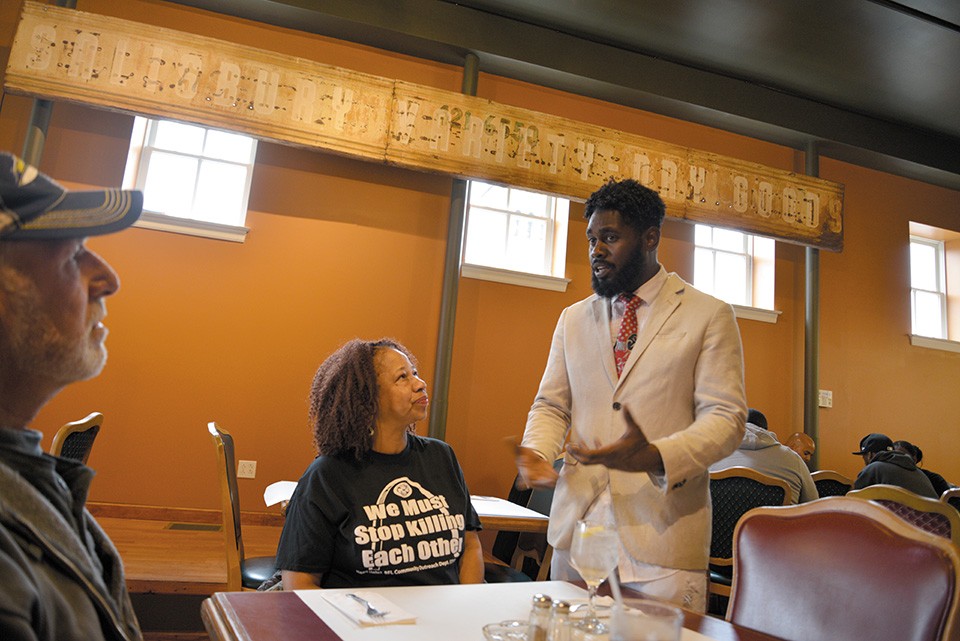
Looking out from the front door of his office on the 1400 block of Salisbury, Alderman Brandon Bosley can spy a little of everything. An empty lot. An empty building just behind that. Painters, dabbing at the windows of the newly opened River Lillie cafe. And cars. Hundreds and hundreds of cars, making their way east and west on Salisbury. He hopes they’re seeing something new in the 2018 version of Hyde Park.
“There’s a certain energy you feel when you drive through Hyde Park,” says Bosley, 31. “We need residents to come in and support any commercial base that we have and if we build commercial spaces without residents, we’ll have to entice people to come in and spend their money. We’ll maybe have to make it a place where they want to live. And though they don’t exactly go hand in hand, we want to build a place where people want to live.”
To do that, it’s not just about numbers. It’s about, yes, people. He actively encourages neighbors to wave when a car’s slowly driving the street, the driver maybe taking down information in a notepad or their phone. He wants them pushing the neighborhood on that level.
“We want neighbors to have investments they feel can be protected,” he says. “The more energy we can build up in the community, we can show it’s good investment. We’ve got one of the busiest streets in the entire city and in any other city, it’d be lit up with commercial development. Thousands of people are passing by every day and things do take time to change, but we need to work faster to make it an attractive area to be in. For me, I see opportunity.
“In most parts of the city, you don’t see vacant lots like we have,” he adds. “So people can complain about them, but here we can build from the ground up. When I get calls, people inquire about having to rent, you’d have to work with a pre-existing structure. But here we can visualize anything we want as a community. We can conceptualize anything. Our area’s historic, we do have historical buildings, but also a lot of open land.”
Bosley comes from a political family, his surname known to even casual watchers of city politics. His dad is Freeman Bosley Sr., and his mother Lucinda Frazier serves as the ward’s committeewoman. Freeman Bosley Jr., his half-brother, served as St. Louis mayor from 1993 to 1997. A sister, Lakeysha Bosley, will be the 79th District’s representative in Jefferson City after the November election.
Brandon Bosley was elected to the post in April 2017, after defeating five other candidates in the Democratic primary. He previously worked for the city’s parking division and, according to a St. Louis Public Radio profile, is also a computer programmer who has created smartphone games. He was one of six new aldermen to join the board after the 2017 elections.
He’s earned respect from his colleagues. “I’ve been really impressed with the thoughtful approach Brandon Bosley has taken to legislation,” says Alderwoman Cara Spencer. “It’s easy to assume that with a name like Bosley he was handed the job, but it’s clear that Brandon works hard for his community and for the city as a whole. Where sometimes there is a clear north/south division, Brandon is always one of the first to transcend geographic and racial boundaries.”
Says Annie Rice, “Brandon sees the forest through the trees, and even when we disagree, I know that Brandon is working hard with his and our community’s best interests at heart.”
He’s not afraid to court controversy. He lists something he’d like to bring to Hyde Park that would be a third rail in many parts of the city: a Walmart. Whether within the boundaries of the neighborhood, or one nearby, Bosley sees both the need and want for big-box development.
He sees it as something that could spur more human-sized projects. “I would take any large commercial development that would bring in traffic to support a corridor of mom-and-pop stores,” he says. “To bring up the tax base, get more money flowing through the neighborhood. One large business would help us eat off of that traffic and give a boost to the morale of the neighborhood.”
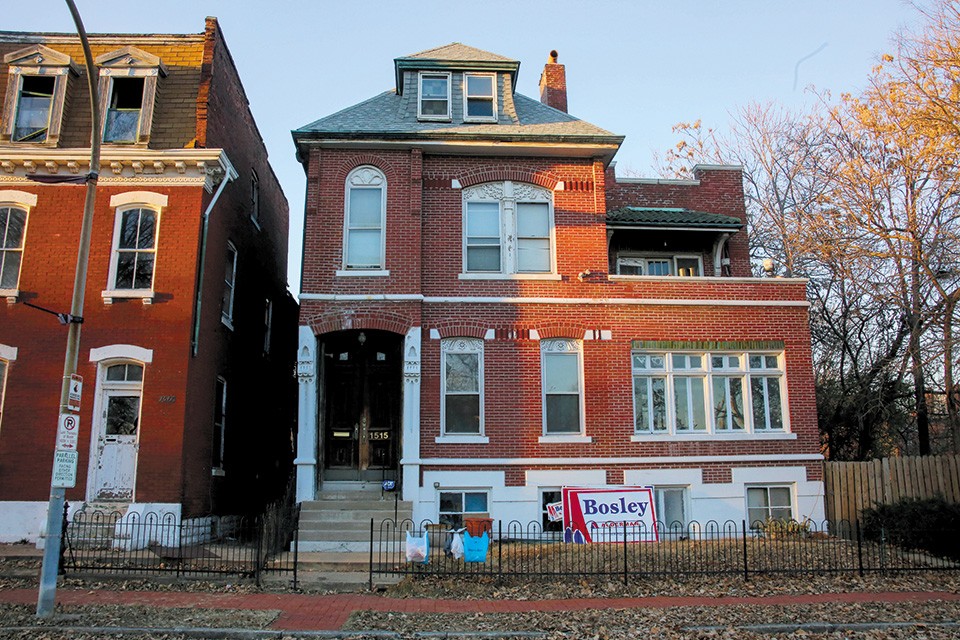
Over and over, he ponders the role of Salisbury Street. How it enters the city’s street grid at the end of the McKinley Bridge to Illinois. How it heads east, then curves into its new name, Purnell. And how Purnell quickly turns into Jefferson, mere minutes from the NGA site. From Bosley’s storefront office to the edge of downtown, it’s only an eight-minute drive.
,p>Proximity, Bosley says, will eventually prevail over a lot of other past issues.“The most positive thing,” he says, “is that this is the only street in the entire city that takes you north and south, from one side of the city to another state. It’s extremely unique. You’re close to 40, 70, Illinois. And all of that is the pipeline, the infrastructure to have an amazing amount of development in this area: commercial and grassroots. Everything’s about transportation, and having one of the busiest streets in the city can help us change everything.
“It’s a place, I might add,” he says, “that is very close to downtown. People can sit on their porch and see the Arch. It’s beautiful from an opportunity perspective. There’s nowhere to go but up. When lots aren’t being cut, it’s frustrating. When the city isn’t capable of maintaining thousands of vacant lots and houses, there’s frustration that can come from that. When a space becomes empty and we’re not adding more people, when we have more people leaving, it creates an impression.”
Another impression?
“In Hyde Park there’s no racism,” he says, a statement echoed by a few. “White and black people work together here. When you have neighborhood disputes, it’s over how a neighbor parks a car, or music that’s too loud. There’s not a high population of white people, but the ones here get along. Racially, there is not an issue.”
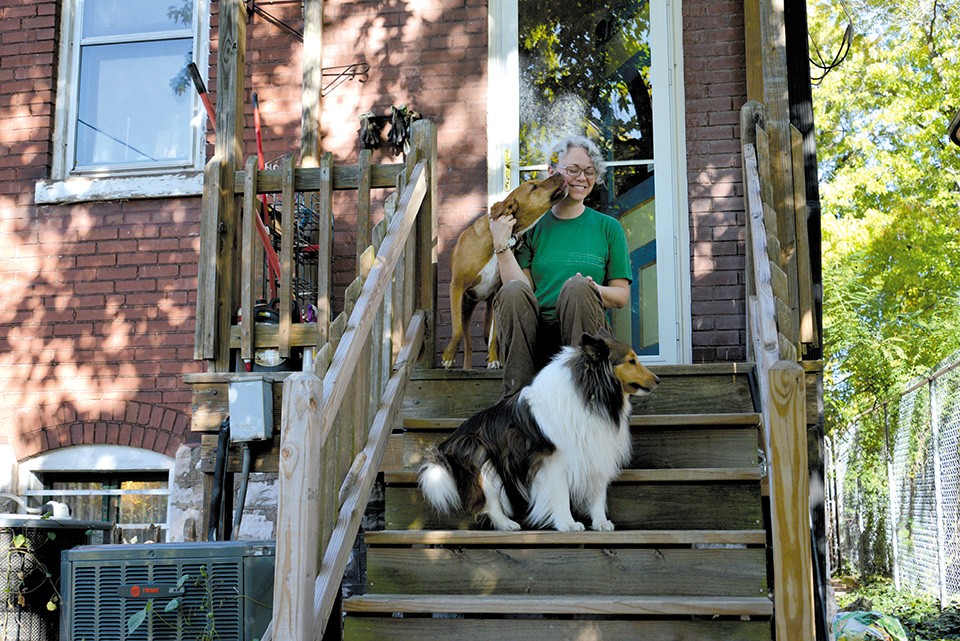
Julie Longyear is one of the residents who does wave to people driving by, even though her block is a relatively quiet one, with North Park Place dead-ending up against I-70. She’s a few houses removed from the passing highway, with the hum less pronounced than even a few homes to the east. To Longyear, 41, the sound has become a natural part of the environment, a complementary tone to the wind rustling through the heavily wooded block.
Other residents on her block have been here longer, but she’s logged real time, too, with about thirteen years of residence in a home that she’s slowly rehabbed as time and money have allowed. As time has gone on, she’s become an unofficial spokeswoman, though she blanches at the term. For whatever reason, perhaps her public role as the owner of Blissoma (a holistic, raw, organic and vegan skincare line) or other appearances in media, when discussion about Hyde Park boils up, she’s suggested as a go-to.
Her patient, nuanced replies suggest another good reason, too.
“My neighbors Don and Nancy,” she says, nodding down the block, “have been here over 30 years. Probably 40. They were in the first wave of rehabbers in the 1970s, part of the Hyde Park Restoration Group that got the historic district put in place. They were more organized than even the folks in Old North. But they lost momentum. Partly that was due to crack moving into the area in the 1980s, which fucked things up pretty badly. There was an increase in violence and drug problems in that particular time period, which drove a lot of people away and gave a reputation of being pretty violent.”
In a sense, Longyear figures, “the whole American Dream changed. People used to live in tighter-knit communities like this. The whole perception of raising a family, buying a house … people wanted a bigger piece. Here, you’re a little closer to your neighbor, you have to work more together.”
And you may also have to work more for yourself.
Longyear points to her own house, which is not quite finished even after a decade of work. She can recall nights and weekends spent on projects, rather than socializing. Dollars could have alleviated some of the work, but she chose to attack the problems herself, rather than bidding out the work. Partially, that’s due to her abilities. It’s also partly due to wanting to keep her house within the parameters of neighborhood housing values.
She references, for example, a home recently opened up by the death of its owner. She feels that someone could live in the house, but the lack of updates, a bad HVAC system and a general sense of wear makes it the type of property that could also slide from recently inhabited to problem property within a short period of time.
“I’ve said this for a long time,” she says. “There needs to be some type of financial partnership between the city and local lending institutions, which would be a huge help for some of these properties. Redevelopment loans could be accessible, more open. Instead of just tax credits, some other mechanisms for construction work or reinvestment could happen. Developers could get gap funding. It’d be a big help to get more individual developers up here, truly invested in the neighborhood itself. It’s not doing the city any good to have LRA [land bank] properties rotting away. If there was some sort of extra loan, where you didn’t have to come up with all the money on the front end, where there was a way to fund that gap ...”

Longyear has been awaiting changes in Hyde Park but admits that the neighborhood’s long-term prospects remain a bit up in the air. Sure, there are some restaurants now and some key buildings have been preserved, but the overall density is still low, public transportation is dodgy and food stores are scarce. The amenities that draw interested parties flag, at times, compared to similar neighborhoods in other parts of the city, despite the best guesses of real estate agents and trend watchers.
Initially, Longyear moved to the area while married and living on the western edge of the city, on Dogtown’s border with Richmond Heights. She and her spouse were part of an early 2000s run on some of Hyde Park’s most handsome homes. Unfortunately, they bought just prior to the housing bubble’s burst. Their home, purchased at $120,000, suddenly stood out from neighbors going for $60,000.
Longyear recalls a real-estate-agent friend who felt Hyde Park had some of the same ingredients for renewal that Lafayette Square once had. After being discovered by rehabbers who brought back a neglected neighborhood one house at a time beginning in the late 1960s, Lafayette Square has solidified its place as one of the city’s best comeback stories.
“While Hyde Park wouldn’t ever be as densely populated,” Longyear says, “it seemed the opportune moment to invest here and get in. I liked the building and the price and knew it was a long haul.”
Her place, while not finished to her full satisfaction, has the curb appeal of those homes in Lafayette Square, a handsome brick building on a tree-filled street. But there’s a vacant lot across the street and some board-ups just around the corner, and, with it all, it’s hard for outsiders (and even some insiders) to believe that Hyde Park can turn the corner away from Hype Park.
Still, for Longyear, the neighborhood has been a good choice.
“I really like my time here,” she says. “My neighbors on the street are fantastic. I love that there’s no traffic, while my friends are in bumper-to-bumper traffic on Hampton. There aren’t many stoplights and I can sail down Jefferson with no problems. Even though I do have to drive for restaurants, they’re still not far away, maybe twenty minutes to most things. It’s one of the most affordable areas for the size of the buildings, and I’m paying a quarter of what other people are paying a month. That has its advantages.
“I like seeing things move and seeing how a change can come about. I’m not driving the whole thing, I’m just doing my little part. But I get the sense that something big could happen here, should happen here. I hope to get to watch that happen. It’d be exciting, but not everyone gets their jollies off of signs of progress. Most people want a sure thing, not potential.
“I’m weird,” she adds. “I have sort of a love affair with derelict buildings, but I also really wanna see key pieces of architecture saved. It’s a both/and equation for me. I like the neighborhood. I like living in an old neighborhood, and I like things with potential, too. There’s a real sense of being happy when another, good-quality person is taking care of a building. There’s not much concern over whether you’re black or white when someone’s moving in here. If you’re invested in a building, you’re happy to see someone decent as your neighbor.”
Hyde Park, she says, “has always been a little different than other city neighborhoods. So much remains to be sorted out. I’m stuck here for a while longer — I’ve got more work to do.”

Telie Woods, 42, and Zahra Spencer, 33, freely admit they wouldn’t be in Hyde Park if not for bad weather. As the couple first told the RFT’s Cheryl Baehr a few months ago, they had been planning to open a restaurant in St. Thomas, with Woods relocating from Chicago to be with his long-distance sweetheart in the Virgin Islands.
Just one week after Woods arrived, Irma struck, devastating the island. Spencer stayed with her family in St. Thomas, but Woods evacuated by boat to Puerto Rico.
And then came Hurricane Maria. A St. Louis friend of Woods’ helped him secure a ticket on one of the last flights out of San Juan before the hurricane hit. And after that, he ended up in St. Louis, too.
As Baehr wrote, “The pair still wanted to open a restaurant, but now that the islands were devastated, they knew they could not do it in St. Thomas. Something told [Woods] to begin searching St. Louis for a space, and within three days, he’d found a completely renovated restaurant waiting for its first tenant in the middle of the Hyde Park neighborhood. Immediately, he knew it was the right fit.” Not long after, Spencer joined him, and they opened Jerk Soul.
Now clicking as a takeout-only operation, Jerk Soul runs six days a week, the pair taking off for the sabbath on Saturday. “That’s probably the most busy day for a lot of restaurants,” Woods says. “But we’re not open because of our faith. Yes. Saturday is the original sabbath, a high holy day. We actually don’t do any work on that day, whatsoever.”
That leaves the other six days, though. And on those they work hella hard.
On a recent Friday afternoon, between the lunch and dinner rushes, a small crop of folks gather in Jerk Soul’s small, shallow lobby. In the seriously expansive kitchen, Spencer works the ovens while Woods dodges a small rain shower at his uncovered grill alongside the building, cooking up some of the 120 pounds of chicken the pair serve on an average day.
Located about a half block from the park version of Hyde Park, Jerk Soul is now part of an emerging restaurant zone. Just down the block is the Cornerstone Cafe. It was founded in 2003 by Denise and Dan Ulmer, who on a recent day are working alongside three of their six kids as grandchildren bounce through the candy-colored restaurant. The building was once (amazingly) known as Beaver’s Pizza, among other concepts, before the Ulmers began their successful run. Their clientele comes largely from workers at nearby businesses, who stop by for lunch, served atop formica tables; delivery is also available.
Across the street from them is the River Lillie, which offers a variety of fare in a freshly rehabbed, sit-down space. Highlighting a breakfast-and-lunch menu, with an emphasis on “chicken, fish and burgers,” the room is also home to select nights of live entertainment. Owner Maggie Hourd-Bryant told the RFT she’d come to St. Louis to pursue her PhD at Wash U — and, after originally settling in Clayton, found a home in the Fairgrounds neighborhood. As soon as she saw the “for lease” sign on the River Lillie’s newly renovated building, she knew she wanted to open a restaurant there.
“If we can rebuild it, we can reclaim its former glory,” she said in August. “It’s not about new developments but about accessing what is already available here — the buildings and the people in the community.”
The more the merrier, says Woods, figuring that attention on one restaurant can only help the next.
“Obviously, we’re a new business, so we want to ask where people have heard of us,” he says. “A lot of people say, ‘Hey, we’ve seen you through social media.’ Fifty percent, though, are word of mouth. ‘My co-worker recommended me to you guys,’ or, ‘It was lunchtime and I saw a plate, where’d you get that from?’ ‘Jerk Soul on Salisbury.’ That’s combined with the actual neighborhood.
“The buzz about us here has been pretty amazing. People are like, ‘Hey, there’s this new place in Hyde Park. The prices are good and the food is nourishing.’ It’s an underserved area and they were looking for something like this. Let’s be honest: It’s a food desert. For a lot of people around here, there haven’t been a lot of fresh food items. They want to eat more healthy and are tired of eating pizza out of a gas station. I think we’re partly providing a solution to a local problem.”
For years, the neighborhood’s previous alderman would tout the street as having the potential to be the next Beale Street, or, as audaciously, the next Bourbon. Right now, a marginally more robust Salisbury Street would be plenty for many residents. Jerk Soul hopes to be part of that, providing a place that’s actually making it, as opposed to a drawing on paper.
“Yeah, that’s a fact,” says Woods. “I don’t feel any pressure, as far as that goes. I feel some responsibility, though. I feel that we’re responsible to not just be successful for six months, but for the next six years. That’s what we’re looking at, the long term. We’re excited at the coming updates to the area, to be kind of a flagship business and help lead the charge.”
As for Spencer, she hopes the carryout eatery might lead to a second shop.
“We’re probably wanting to have a sit-down,” she says. “We want the full experience. Good food served in a good atmosphere. Maybe create some Caribbean vegan food, since we don’t want to disappoint our meatless friends.”
Mind you, there are vegetarian options at Jerk Soul now, though it’s the chicken that’s proven key to drawing new customers. Another, bigger key is getting people into the idea that Hyde Park is not all that far from where they work or commute.
Asked for her pitch to customers who are unaware of Hyde Park or disinclined to visit north city, Spencer offers an interesting twist.
“I would tell them that Hyde Park is a community of smiles and diversity,” she says. “There’s a community within a community here. There’s so much opportunity here, with a lot of buildings that people are starting to buy and renovate. It’d be a missed opportunity to not venture into this area. They’re doing themselves a disservice in not coming down here.”

